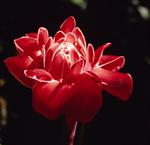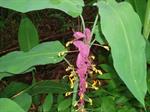 Learn to identify and grow a wide variety of different tropical plants
Learn to identify and grow a wide variety of different tropical plants
- Inside or Out
- As garden plants in a mild or warm climate
- As indoor or greenhouse plants anywhere
COURSE CONTENT
This course has been divided into the following ten lessons:
1. Introduction to Tropical Plants
- What does the term "tropical" mean?
- What tropicals grow where you live?
- Plant names/classification (scientific and common).
- Species, hybrids, varieties and cultivars.
- Growing Tropical Plants in different climates: tropical, sub tropical, arid and temperate.
- Climatic Variations; seasons, mountains, savannahs, rainforest, coastal.
- Gardening for Warm Climates and Microclimates.
- Good and Bad News about Tropical Gardening.
- Heat Traps, Warming a Garden, Greenhouses.
 2. Plant Cultural Practices
2. Plant Cultural Practices
- Common Gardening Problems.
- Understanding soils, naming a soil, texture, pH, fertility, nutrition, feeding.
- Water and Plant Growth.
- Water deficiency and excess symptoms.
- Water Dynamics in a Soil.
- Planting and Plant Establishment Methods.
- Light Requirements.
- Mulches.
- Tree Guards.
- Weeds.
- Propagation,cutting, seed, propagating media.
- Potting Mixes, Potting up, Caring for young plants.
- Pruning etc.
3. Tropical Annuals, Perennials, Bulbous Plants, Bamboos And Lawns
- Bamboos, Grasses and Grass Like Plants.
- Landscaping with Bamboos.
- Review of Bamboo species.
- Review of other herbaceous tropicals, including: Achmines, Agapanthus, Alocasia, Amorphophallus,Aristea, Babiana, Boophone, Brunsvigia, Caladium, Calaqthea, Calostemma,Clivia, Calocasia, Crinum, Crocosmia, Cyrtanthus, Dierama, Eucharis, Eucomis, Gladiolus, Gloriosa, Zephranthes, Hippeastrum, Hymenocallis, and many others.
- Lawns.
- Turf Varieties for Warm and Hot Areas.
4. Ornamental Gingers and Heliconias (and related plants)
- Introduction
- Zingerbales; Musaceae (bananas), Strelitziaceae (bird of paradise), Lowiaceae, Heliconiaceae (heliconias), Zingiberaceae (gingers), Costaceae (costus), Cannaceae (cannas), Marantaceae (prayer plants).
- Gingers.
- Heliconia.
- Costus.
- Canna.
- Strelitzia.
- 5. Cordylines, Palms And Cycads
- Types of Palms; self cleaning, cleaning, solitary or clumping, fan or pinnate, etc.
- Palm Propagation.
- Review of many cultivated Palm Genera.
- Cordylines.
6. Climbers, Shrubs And Trees
- Review of many cultivated Tree and Shrub Genera.
- Cultural Requirements.
- Review of many selected species characteristics.
- Conifers; culture, genera, species.
- Climbers; Allamanda, Antigonon, Aristolochia, Beaumontia, Bignonia, Bougainvillea, Campses, Ceropegia, Cissus, Clematis, Clerodendrum, Clitoria, Clytostoma, Combretum, Congea, Ficus, Hoya, Ipomea, Manettia, Mucuna, Pandorea, Philodendron, Scindapsis, Stephanotus, Thunbergia, Trachelospermum.
7. Orchids, Ferns, Aroids and Bromeliads
- Orchid introduction.
- Growing Orchids.
- Epiphytes.
- Orchid Genera.
- Bromeliads.
- Growing Ferns.
- Types of Ferns; Fern Classification and families.
- Fern Culture.
- Aroids.
8. Tropical Herbs, Vegetables and Fruit Bearing Plants
- Growing Methods; organic, no dig, permaculture, Container Growing, Hydroponics, etc.
- Culture of Selected Vegetables in tropical and sub tropic conditions.
- Bush tucker.
- Tea and Coffee.
- Tropical Fruit trees.
9. Growing Tropical Plants outside the Tropics
- Growing tropicals indoors.
- Growing in different climates and conditions.
10. Landscaping with Tropical Plants
- Use of colour and texture.
- Plant selection.
- Planting a courtyard.
- Preparing sketch plans.
Course Duration - 100 hours
WHAT IS A TROPICAL PLANT?
This course takes a very broad approach to tropicals. It can be any plant that is conssidered to be "tropical" either because it comes from a warm climate or because it looks tropical. Often plants that appear exotic and different, and have lush foliage, may be described as "tropical" in cool climates, even though they may not have originated in that type of climate. Tropical plants are grown as garden plants in warmer climates or microclimates (eg. warm courtyards or terraces). They are also often grown as greenhouse or indoor plants.
Tropical climates are found in South-East Asia, much of India, northern Australia, Central America, the Caribbean, Northern parts of South America, many of the Pacific islands and perhaps the central half of the African continent. Tropical areas in general have the highest average temperature levels, the longest frost-free growing seasons, and the greatest amount of light (intensity and duration), compared to other regions on the planet.
Tropical gardens can vary from dry and desert-like, to coastal, to dense, lush and leafy environs resembling the dynamic workings of a rainforest. Many different garden effects are possible using tropical plants. You can also, on a small scale, transform a garden into a microclimate using tropical plants that are not normally found in your locality.